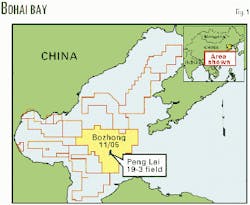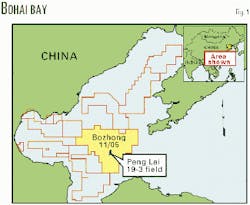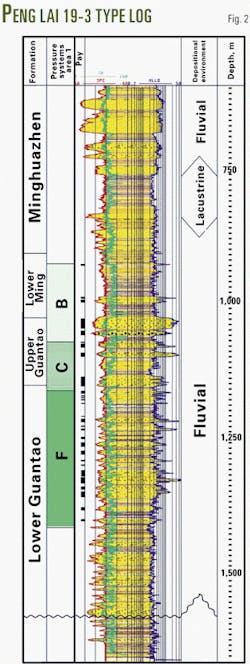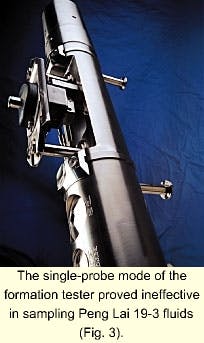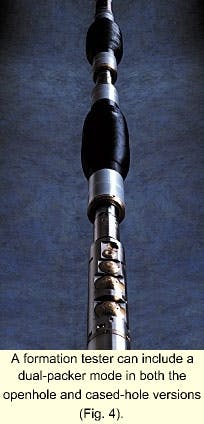A cased-hole formation tester proved to be a viable alternative for obtaining reservoir fluid samples and pressure data for characterizing an offshore China oil field.
Phillips Petroleum Co. in 1999 ran 25 tests on wireline in seven wellbores in the Bohai Bay Peng Lai 19-3 field, containing stacked, unconsolidated heavy oil reservoirs (Fig. 1).
Phillips originally had planned to run drillstem tests (DSTs) but decided otherwise because of the number of DSTs required and the presence of the heavy, viscous oil. The unconsolidated formations and heavy oil also precluded use of an openhole formation tester.
The cased-hole formation tester run was Schlumberger's Modular Formation Dynamics Tester (MDT).
This first of a two-part series discusses uses of the formation tester as an alternative to traditional drillstem and extended well testing. It also relates the experiences that led to selecting the cased-hole formation tester as the optimum tool for obtaining reservoir data at Peng Lai 19-3.
The concluding article describes the tool and a standardized procedure that evolved during its use in the challenging Bohai Bay environment.
Test selection
After Phillips drilled its discovery well at Peng Lai 19-3 in May 1999, preliminary tests revealed that numerous layered, productive zones had a wide range of reservoir pressures, fluid properties, and formation permeabilities.1 As appraisal drilling progressed, it became apparent that the testing needed to characterize the reservoir was more extensive than originally expected.
The formations displayed complexities and heterogeneities, and oil pressure-volume-temperature (PVT) properties varied widely between zones. Thus, Phillips required a comprehensive appraisal program for its development planning.
Data collection costs would have been excessive if Phillips had to rely solely on conventional DSTs. The heavy, viscous oil that prevented natural fluid flow to the surface and the complicated production handling and storage requirements, particularly during cold weather, would have been problems for DSTs.
As a result, Phillips evaluated the feasibility of wireline formation testers. In certain circumstances, these wireline testers have proven viable alternatives to conventional DSTs.2 These testers usually are run in open hole to obtain in situ fluids, locate fluid contacts, and evaluate reservoir performance.
Running an openhole tester in certain formations, such as unconsolidated sands and unstable shales, can be difficult because of the potential for formation collapse, differential sticking, and sand production.
This was the case at Peng Lai 19-3, where productive reservoirs consist of a series of stacked, unconsolidated sandstone layers. The heavy, viscous oil also would have prohibited an openhole tester from collecting high-quality fluid samples or reliable mobility data.
The cased-hole version of the tester solved many of the problems encountered with both the openhole tester and DSTs. Its ability to acquire pressure build-up data was an added benefit to the original program, which had called for collecting only representative fluid samples.
Well tests
For a long time, the industry has relied on DSTs for determining the fluid type, well productivity, and reservoir performance of development prospects. But in recent years, operating companies have sought alternatives to DSTs and extended well tests that would improve project economics, ensure personnel safety, minimize environmental impact, guarantee confidentiality, and conform to regulatory requirements.
Modern wireline formation testers run both in open and cased holes can provide a technically sound, cost-effective means to obtain certain reservoir data.
These testers allow downhole sampling operations that are easy and quick to plan, and they also reduce safety and environmental risks, surface testing equipment requirements, and total project costs. As a result, formation testers have been used increasingly in recent years for collecting reservoir fluid samples and gathering formation pressures.
These testers initially collected mainly reservoir fluid samples, which often may be as useful as petrophysical log results.3 Accurate information regarding hydrocarbon type, physical and chemical properties, and PVT behavior of the in-place fluids helps to design well completions, facilities, and processing equipment.
On a more limited scale, formation testers also have been used to acquire pressure data for pressure transient analysis, which can determine various reservoir properties. Although, the formation tester program at Peng Lai 19-3 field primarily obtained fluid samples, it also provided short pressure build-ups, lasting about 2 hr.
The wireline formation tester has a wide range of applications because of its modular design. Modularity allows the tool configuration to be optimized for each particular application. Formation tester applications include:
- Identifying hydrocarbon presence and type.
- Obtaining high-quality representative fluid samples.
- Monitoring pressure differences between wells.
- Obtaining reservoir mobilities.
- Conducting minifrac tests for in situ stress measurements.
Fluid sampling was vital at Peng Lai 19-3 because resistivity similarities between oil and fresh water made determining formation fluid type uncertain. In addition, fluid properties varied significantly within individual wellbores and across the field.
The pressure data and subsequent transient analyses obtained at Peng Lai 19-3 were comparable to those obtained from cased-hole DSTs.
Peng Lai
Peng Lai 19-3 field's Lower Minghuazhen and Guantao formations have numerous poorly consolidated to unconsolidated sandstone beds layered throughout a 2,000-ft thick interval (Fig. 2). The productive formations are shallow; with the top of the Lower Minghuazhen at 2,500-3,000 ft.
These reservoirs have a normal 0.434 psi/ft pressure gradient from surface, and reservoir temperatures are a relatively low 120-150° F.
The produced fluid contains no H2S, but significant amounts of CO2 have appeared in two wells near the middle of the field.
In addition to fluid uncertainties, extensive reservoir property variations exist in these complex reservoirs. For example, openhole formation tester pressure analyses revealed multiple pressure systems, both vertically within each wellbore as well as areally across the field.
Permeabilities also varied and could not be determined reliably with standard openhole logs. DST pressure-transient-analyses permeabilities ranged from 100 md to several darcies and mobility was 1-150 md/cp.
Reservoir fluid properties also varied, with oil gravities ranging from 11° to 21° API and GORs from 50 to 300 scf/stb.
As previously stated, the low-resistivity contrast between oil and fresh water made fluid determination difficult. Although oil-bearing zones often could be identified from resistivity logs, several zones originally identified as water-bearing later flowed 100% oil.
Reservoir property variability and fluid uncertainty required thorough reservoir characterization to aid in development planning. The appraisal program, therefore, required high-quality fluid samples, reservoir pressures, and formation permeabilities.
Testing comparisons
Although the field required a comprehensive appraisal program, the operator soon recognized the need for an alternative to conventional testing methods. The reservoir's nature and fluid types created operational and logistical problems.
The heavy, viscous oil within thin, unconsolidated sand layers complicated and at times prevented sampling operations using the DST tools and the openhole version of the wireline formation testers. Moreover, the extent of data acquisition required for adequate reservoir characterization would have been prohibitively expensive with only DSTs.
The cased-hole tester increasingly was used as problems mounted with both the openhole formation tester and the DST tools.
Openhole vs. cased-hole testing
The openhole tester obtained extensive formation pressures at Peng Lai 19-3 field, but it had limited utility for collecting fluid samples and formation mobilities. The formation prohibited fluid sampling with the tool's probe module (Fig. 3).
Openhole sampling operations often encountered high-pressure drawdowns, attributed to damage from formation collapse, fines migration, and fluid invasion around the wellbore.
The low heavy, viscous oil mobilities also increased drawdowns, which could drop sampling pressures below the bubblepoint, thus compromising fluid sample quality.
Sand production resulting from the high drawdowns and high oil viscosities could plug the formation tester's probe, screen, and flowline. These plugging problems required numerous trips to resolve.
In formations that are highly invaded or damaged, the openhole tester does not extend into virgin reservoir because of its shallow radius of investigation. Mud filtrate can change fluid saturations and alter effective permeability of the investigated region. Fines and other mud contaminants can plug pore space and cause near-wellbore damage. As a result, the openhole tester obtained mobilities that were unreliable.
Collapsing formations induced by the high-pressure drawdowns also can affect permeability results, unless the investigated radius extends beyond the skin-damaged region. The openhole tester and the cased-hole tester can be configured with dual packers to expose a longer interval and reduce pressure drawdowns (Fig. 4). Operational risks, however, increase in openhole for several reasons.
Tester operations required taking many data points, thus keeping the tool stationary at each setting for a long period. During these periods, sloughing shales and unconsolidated sands made the wellbore very unstable, and pressure differentials between the mud weight and pore pressure could cause the tool or wireline cable to stick.
Any of these factors could lead to a lost tool or, at minimum, a costly fishing operation; therefore, while the openhole formation tester could include dual packers, the potential differential sticking problems prohibited the dual-packer configuration in openhole at Peng Lai 19-3.
Consequently, the program used the dual-packer module with a cased-hole tester, which did not produce the high drawdowns because the dual packers served to increase flow area compared to the openhole formation tester's probe. Flowing pressures maintained above the bubblepoint enabled representative reservoir fluid sampling.
The lower drawdowns also enabled greater control, thus minimizing disturbance of the physical state and behavior of the fluids sampled.
The low drawdown pressures helped prevent sand production, as well. The large area made possible by the dual packer configuration reduced the load on the sandface, allowing the invading filtrate to be pumped out and the heavy oil to be sampled without collapsing the formation.
The increased flow areas, reduced drawdowns, and extended pump times provided more accurate formation-mobility estimates. The higher, more stable flowing pressure allowed longer flow periods and thus, a deeper radius of investigation.
Finally, the cased-hole tester minimized operational risk. Unlike the openhole environment, the casing eliminated the problems with unstable formations or differential sticking.
DST vs. cased-hole testing
DSTs can evaluate large volumes of the reservoir beyond the range of openhole logs and whole cores. While the Peng Lai 19-3 DSTs acquired formation pressures, mobilities, and fluid samples, time and cost limited their application to a few of the most important zones. Their success varied, depending on the specific situations encountered regarding oil properties, permeability, and sand stability.
High viscosities, low mobilities, and low GORs limited oil flow to the surface. High-pressure drawdowns, therefore, were required to lift the oil, making sand production a constant concern in the highly unconsolidated formations.
The heavy oil column almost equal to formation pressure caused the wells to load up as fluid reached surface. Because gas broke out of solution near the surface, the resulting GOR was too low to help lift the fluids from the wellbore. Conversely, it was too high for the pump tests typically conducted in these formations.
High pour points and viscosities also hindered surface handling operations, particularly during the winter months when temperatures neared freezing. The fluid also negatively affected the flow rates, which required additional backpressure.
Heat tracing the surface lines was expensive and time-consuming. Heat also was lost between sea floor and wellhead.
During DST operations, the problem of inadequate deck space was compounded by inability to burn the heavy oil. The tests required sufficient tank volume on deck to store produced fluids during clean-up and flow periods because the unpredictable and hostile weather often caused a delay in offloading, sometimes for days at a time.
Even the simplest DST in Peng Lai 19-3 field had large equipment, personnel, and time requirements. A typical DST lasted from 5-7 days.
Many of the DST-associated problems could be addressed, but the cost of the solutions started to outweigh their benefits.
The cased-hole tester solved many of the problems inherent with DSTs. The tester eliminated production problems because there was no need to flow heavy oil to the surface. The tool's position directly across from the perforations enabled fluid sampling at near reservoir conditions.
Reduced pressure drawdowns prevented pressures from dropping below bubblepoint, which enabled representative fluid sampling while avoiding sand production.
The cased-hole tester is operationally simpler than DST tools. A typical cased-hole formation tester tool string has less than a dozen modules compared to multiple components in a DST string.
The cased-hole tester also has minimal surface requirements. It needs only a wireline unit and well control equipment.
A cased-hole formation test could be conducted in 1 day, meaning that several zones in a Peng Lai 19-3 well could be tested for the cost of a single DST.
Testing solution
The first use of the case-hole formation tester was in the second appraisal well to determine fluid type in a low-resistivity zone. Its use gradually expanded from providing information about fluid types, to collecting PVT-quality fluid samples, and finally to obtaining reservoir flow property data.
The cased-hole formation tester is not expected to supplant the industry's need for conventional testing methods such as DSTs and extended well tests. It nevertheless can be valuable during appraisal of a field for development, as was the case at Peng Lai 19-3.
In this particular field application, team specialists' confidence in the tester's ability to provide high-quality fluid samples and reliable reservoir properties has led them to rely on it in recent exploration wells.
The next article in this series will describe the cased-hole formation tester, specifically the MDT, and outline a standardized procedure developed while using it at Peng Lai 19-3.
References
- Hurst, S.M., McCoy, T.F., and Hows, M.P., "Using the Cased-Hole Formation Tester Tool for Pressure Transient Analysis," Paper No. SPE 63078, SPE Annual Technical Conference and Exhibition, Dallas, Oct. 1-4, 2000.
- Pearson, M.R., Baxter, M.F.W., Tak, H.K., and Hurst, S.M., "Advanced and Innovative Applications of a Wireline Formation Tester as an Alternative to Well Testing," Paper No. AAPG 5030, AAPG International Conference & Exhibition, Bali, Indonesia, October 2000.
- Crombie, A., Halford, F. Hashem, M., McNeil, R., Thomas, E.C., Melbourne, G., and Mullins, O.C., "Innovations in Wireline Fluid Sampling," Oilfield Review, Vol. 10, No. 3, Autumn 1998, pp. 26-41.
The authors
Sharon M. Hurst is a senior reservoir-project engineer, Bohai exploration, with Phillips Petroleum Co. Since joining Phillips, she has worked as an exploration, test, reservoir, and production engineer. She also was a company well test specialist for 2 years at Phillips' research center, in Bartlesville. Hurst has a BS in petroleum engineering from the University of Texas, Austin, and an MS in petroleum engineering from the University of Houston.
Melton Hows is a senior field engineer with Schlumberger currently based in Tanggu, China. He provides reservoir evaluation and well logging services. His area of expertise is in MDT operations, with extensive experience in Bohai Bay, offshore China. Hows has a bachelor in mechanical engineering from the University of Auckland.
Andrew Kurkjian is the customer needs and product strategist with the Schlumberger reservoir sampling and pressure product line. Previously, he headed borehole seismic research in Cambridge, England and led the cross well seismic engineering development in Clamart, France, and co-invented the Dipole Shear Imager (DSI) tool at Schlumberger Doll Research. Kurkjian has a PhD in electrical engineering, with a specialty in signal processing, from the Massachusetts Institute of Technology, Cambridge, Mass.
